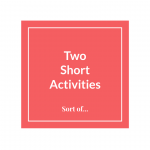Do you have preconceived ideas around education? I do. Even thought I should be free of them, even though I will be soon a teacher, even though I know that my bias could negatively affect my students: I am, after all, human.
You see, I don’t come from an anglophone province. I have never experienced French Immersion or any immersion program. So when I entered my first class of French Immersion, I had no preconceived idea about it. That first experience was so formative and the guidance of that teacher really coloured my first idea about French Immersion and its students.
That teacher told me that French Immersion was not for everyone. She specifically told me about a couple of students that shouldn’t be there. They struggled and they simply didn’t have what it takes to succeed in the program. We had many discussions about it, but the conclusion was always: French Immersion is for a specific type of people. She was an amazing teacher, but she felt that French Immersion was a program for students who performed well and aimed for more. And she was not the only one. I met subsequently a myriad of educators, parents, students, and citizens who believe that French Immersion was for and only for an elite. That is how I viewed French Immersion too.
Fortunately for me, I had the immense chance of meeting people who have changed my idea about French Immersion. When we first got a conference on Inclusivity during our Wednesday seminar, I had the chance to discuss inclusion in French Immersion with our seminar instructor Tasha Liberatore. It was not the first time I had a clash between what I had heard French Immersion is and what it can be.
I always thought that I wanted to be a teacher because I firmly believe that education can help everybody overcome challenges and give them opportunities to be whatever they want in life despite their social class, their upbringing and their story. So when I realized that I had conflicting ideas with French Immersion, it made me want to dig deeper and understand what I could do to make sure I had a class for everybody.
It was important for me to unpack that bias because unlike other times in life, this one could have a dangerous effect on my work and I do not want that.
My inquiry question then became: How can we make French Immersion more inclusive?
I started by finding a definition that worked for me. Inclusivity is, for me at least, means of improving educational participation and opportunities for all. From there, I proceeded to read, interview, question and reflect on the relationship between inclusion and French Immersion.
I have to say, it is not so different than any other classes, but what makes French Immersion such a difficult topic in terms of special education is the reputation: people still believe that having a disability in languages is in direct opposition with the program. Let me cut to the chase, it is not. Following that belief, I found 3 types of exclusion in my research.
1.Systemic exclusion (even with the lottery system):
- FI has been openly challenging the compatibility of students with disabilities related to language and its program.
- Any form of discouragement or exclusion from FI is a tool of oppression.
- And it is without talking about ELL students in FI.
- Some parents don’t even have FI on their minds.
- There is a shift in mentality, but I still feel unprepared like many other teachers.
2. Classroom exclusion:
- Lack of EAs.
- Lack of overall support.
- Pool of fund commons for both tracks.
- Lack of knowledge or expertise about inclusivity.
- Preconceived idea that French Immersion is for an elite student type.
3. Self-exclusion:
- Parents worry about the lack of support for their child with a learning disability or challenge.
- Not an “I can” frame of mind.
- Reputation of the program.
That being said, French Immersion has made tremendous progress in the last decade and during the past semester, I had the chance of meeting a lot of French Immersion teachers who had inclusion on their mind every day. The program is changing, the perception too. When I realized that, I found that I needed to change my question. After all, this inquiry started with my own bias. It was natural to end it with a cure for them.
How can i make my french immersion class more inclusive?
After researching and speaking with a myriad of educators, I have the confirmation that French Immersion can be inclusive and can be for everybody. The only times when we could think about redirecting a student toward the English program is if the student doesn’t want to learn French or be in French Immersion. So, what could I do to make my class more inclusive? I always wanted to be a teacher to bridge gap and give everybody the same chance at growing. Now, I needed to find concrete ideas to put those beliefs in actions.
This is where I found a multitude of documents that would shed some light on inclusivity in the classroom: they would help me understand learning disabilities and universal design for instruction. However, they were all spread through 4-5 documents. While trying to create a unit plan for another course, I found myself scrambling through all those documents on top of everything else I wanted to cover. It was not working. If I wanted to make my class inclusive, I also needed to have actionable ideas. I needed a toolbox with just a few, but powerful tools.
I needed a toolbox
So I created a document gathering all actionable ideas that I could easily implement in my unit plan and lesson plan without having to think about it or prepare more things. I grouped them under a same problematic or need to make it even easier if I had a specific issue in my class. Those were ideas that were useful, clear, easy to implement, and that would make my teaching more interesting for everybody… not just the students with learning disabilities. I also kept with me two documents: Universal design for learning and Understanding learning disabilities (which you can both find on the French Immersion Toolbox page). They were great references for when I felt lost or I needed more clarity on an issue.
With that toolbox, not only did my bias completely disappeared, but also my feeling of inadequacy. I have to say that thinking French Immersion is not for everybody was way easier for me because it meant I didn’t have to make the effort to diversify my teaching, learn about learning disabilities, and open my mind on other’s ways of learning. Despite my desire to be a teacher for everybody, I felt unprepared to open my doors to different types of learners. That toolbox gave me ideas, points of reference, and ultimately the confidence that I can put my intentions in actions.
If you think you would need the toolbox too, you can download it right here.
A toolbox for everybody
It could have been the end of my inquiry, but I felt I could do more to help all my students strive in French Immersion. During a visit to Lansdowne Middle School, I had the immense luck of spending a whole day in a French Immersion class. While chatting with the teacher about my inquiry, we came to the conclusion that students should also have a toolbox to help them with the program.
When boiled down, what a student needs to succeed in French Immersion is very simple: why and can. First, there is a consensus in research that the only time a student should leave the program is when they don’t want to be there. Second, the commonality between all successful French Immersion students is not their grades or their intelligence, but their ability to think they can overcome challenge. In their experiences, teachers found in my interviews that students need to know that they can do it.
So, I have created a little sheet to be completed at the beginning of the school year. It includes a “Why” statement and an “I can” statement along some other questions that could help me support them. I believe that it could be the beginning of something bigger and the students could gather more tools along the way: worksheets, notes, definitions of topics that cause problems for them.
If you think your students could use a sheet like this, you can find it here.
As you can see, overcoming my own bias was not an easy task, but I am glad I picked a subject that shook me a little bit. I believe that as a teacher, it will be important to constantly keep my preconceived ideas in check and work on them because they can have harmful effect on my students. I hope this toolbox will continue to grow and I will continue adding useful information to it. I planned on testing it with my first practicum this spring!



